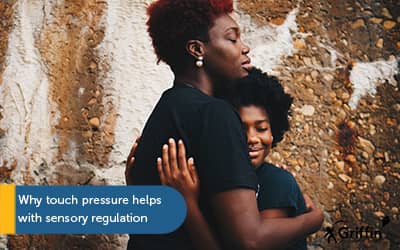Ask Kim – Vestibular Stimming
The Ask Kim posts are driven by the GriffinOT community. Occupational therapist Kim Griffin answers a questions that are sent in. This post’s question explores sensory stimming. The following question was sent in:
“How can I stop my 9 year old autistic daughter from vestibular stimming?” N, Parent
If you would like your question answered, you can submit it here. Please note, you may want to search the GriffinOT website using the search magnifying glass first, before submitting a question. Kim receives a lot of questions that have already been address in existing posts.

Ask Kim – Vestibular Stimming
The Ask Kim posts are driven by the GriffinOT community. Occupational therapist Kim Griffin answers a questions that are sent in. This post’s question explores sensory stimming. The following question was sent in:
“How can I stop my 9 year old autistic daughter from vestibular stimming?” N, Parent
If you would like your question answered, you can submit it here. Please note, you may want to search the GriffinOT website using the search magnifying glass first, before submitting a question. Kim receives a lot of questions that have already been address in existing posts.
Sensory stimming – I will start with a warning
I am thankful for the question which has been submitted, but would like to begin this post with a warning. The post will discuss sensory stimming and explore the reasons for it. It will provide some strategies to consider when a sensory stim may be unsafe. However, it is not going to provide a magic bullet to stop stimming. In fact, my hope is that I will be able to help N to rethink her question.
So my warning is, if you are looking for the answer to stop sensory stimming, you may want to find another article or opinion. However, if you have come here with an open mind and are ready to start to change your perspective, I invite you to read on.
What is a sensory stim?
As some readers may also not be familiar with the term vestibular, or stimming, I will describe these first. Stimming is the name that is given to repetitive movements or actions, it is usually associated with autism. Common stims include hand flapping, looking persistently out of the corners of the eye, watching spinning objects, and jumping. Some children may also have vocal stims where they repeat phrases or sounds.
What about vestibular stimming?
Vestibular relates to the our movement sense. You can read more about this sense here. Putting this together, vestibular stimming is a sensory stim that includes movement. This might be jumping or spinning. It could be rocking. Head banging is another example of a vestibular stim. Some children really like having their head upside down and will manoeuvre themselves into very interesting positions.
Why do autistic children (and adults!) stim?
In my experience sensory stims occur for three reasons.
An eloquent description of sensory stimming from an autistic perspective
In this video Agony Autie describes stimming and gives insight from a personal perspective. She explains that ‘stimming is a great way to combat sensory inputs’ because the stim helps to ‘block the inputs.’ So, it helps with regulation.
Sensory stimming and regulation
As Agony Autie described, stimming is often an attempt to regulate. This might be due to sensory overload. Sometimes, it can be from excitement. Either way, the individual is using the stim to help them to organise, or regulate, themselves. I explore regulation further here.
When the individual is overloaded, it’s important to help to reduce the overload. This might be by changing the environment, ourselves or the activity. We discuss many strategies for this in our training Sensory Processing with GriffinOT. Also, sensory strategies like heavy work, oral activities or weighted products may help the individual to calm down.
Should our goal be to stop stimming?
If you have time, this 20 minute TED talk by occupational therapist Amy Laurent offers a helpful perspective. She describes her experiences supporting autistic children using a behavioural focused approach. Her first question was, ‘Why do I need to discourage the stims?’ This has led to her ongoing research on ‘Why did the children engage with these behaviours?’
Her examples remind me of many children I have worked with and makes me very grateful that the first approach I experienced was sensory integration and not behavioural. I always nod my head when she starts talking about ‘quiet hands,’ as her opinion echoes some of my own experiences.
Her explanation of why ‘extinguishing autistic stimming behaviours’ is not an appropriate goal is also very clear. She challenges us to rethink and understand stimming behaviours within the context of autism. The experiences from autistic adults are also powerful.
“The behaviour in question was more than just ‘a behaviour’ to me, it lay at the very core of who I was. I don’t know why I had that instinct but I just did. And, it made the hurt doubly worse as they weren’t just criticising the behaviour. They were criticising the very fibre of who I was.” Michael John
When should we stop vestibular sensory stimming?
There are two occasions where, in my opinion, vestibular sensory stimming should be redirected. The first is if the sensory stim is unsafe. The second is when the stim is being done to the exclusion of any other activity.
Unsafe sensory stimming
I would consider a stim unsafe if the child was at risk of hurting themselves. For example, head banging into a hard surface. Or, spinning when walking near traffic. In these instances it is essential to keep the individual safe.
Firstly, it is important to consider the Why? Why is the child stimming? If it is because of sensory overload or dysregulation then changes to the environment or the activity may need to be made. These changes need to be made first.
If these changes are made and the individual continues to be unsafe with their stim, then it will need redirecting to a safer option. It is important to consider which senses the individual is targeting with their stim when you are looking to redirect it. If the stim is seeking out vestibular input, then replacing it with something that provides proprioception typically won’t work. The redirection needs to target the same sense as the stim.
As an example, if a child is head banging into a wall, a safer initial redirection could be to head bang into a big cushion or bean bag. Then a redirection to a swing or rocking horse or rocking chair might help to provide the sensory input the individual is seeking with their stim. Visual supports are often helpful to show the redirected behaviour. A social story may help. Each child is different, and every space has different resources, so there is no exact answer.

Sensory stimming to the exclusion of other activities
Some individuals will not engage in anything else except for their stim. Again, it is important to consider if they are using it to regulate. If this is the case, then changes need to be made to the environment, demand and/or activity.
Once this is considered, then using strategies designed to help with joint attention and engagement can help. These strategies are specifically designed to help autistic children to notice and engage more with their environment. In addition, they are approaches that help to create order and structure. Examples include
- Floortime
- Attention Autism
- Intensive interaction
- Sensory integration therapy
- TEAACH
- SPELL framework (primarily for schools)
These approaches are all designed to help improve the underlying difficulties children with autism have with engagement. Some also help with the need for structure and routine which helps to reduce overall arousal. They provide a framework for expanding the range of activities the child can access. In the case of sensory integration, the aim it to help the child to better organise their sensory experiences.
Advocating for loud hands
Research by Steven Kapp is finding that everyone stims, just that some stims are less obvious and more socially accepted. He advocates for embracement of stims or ‘Loud Hands’ and acceptance. He’s not alone, there is a growing request from within the autism community that perspectives needs to change. So, it is not the sensory stim that needs changing, but society’s perspective of it.
A final note
Beginning this article with a caution, I did advise that I would most likely not be giving the answer the parent was looking for. If you have read this far, my hope is that I have been able to give you some insight into stimming. For me, the real question is “Why is the stim occurring and what can I do to support the individual?” In many cases additional support for sensory regulation is needed first. This might be a change in the environment, task or person working with the individual.
Finally, as Steven Kapp advices, acceptance is important. Whilst societal perspective shift is the ultimate goal, change begins one person at a time.
Other resources
The Reason I Jump by Naoki Higashida is a great book. Written when he was 13, Naoki explains things like why he talks loudly or repeats the same questions, what causes him to have panic attacks, and why he likes to jump!
If you want to read more about autism from an autistic perspective, the Spectrum News website has many useful articles.
To learn more about sensory processing and the senses, take a look at our free introductory course.
And, if you would like to learn more about sensory strategies which could help with regulation, you can join Level 2 & 3 of our sensory training.



